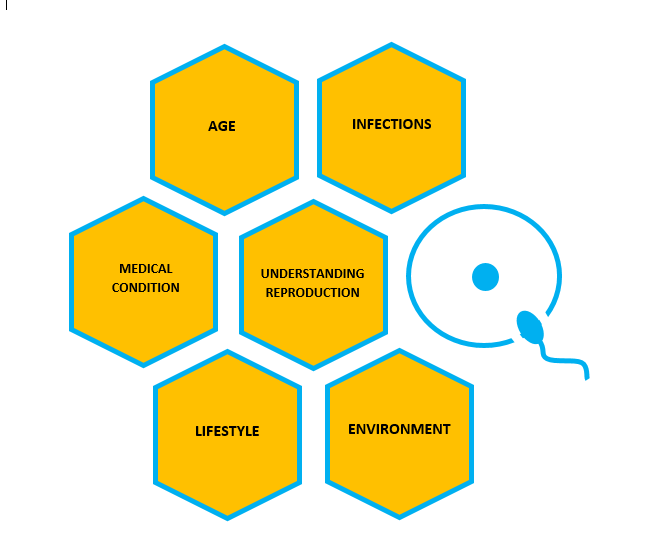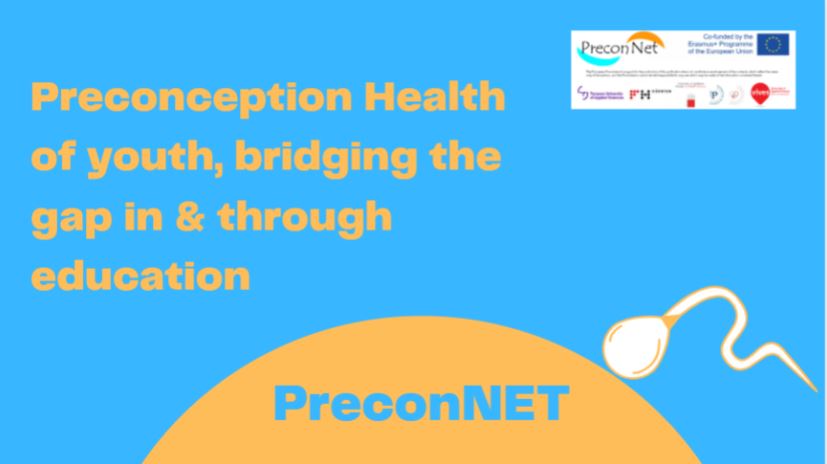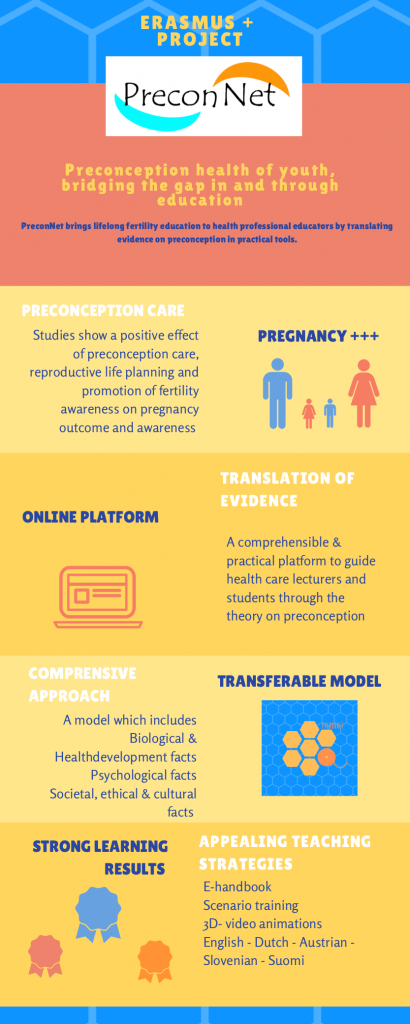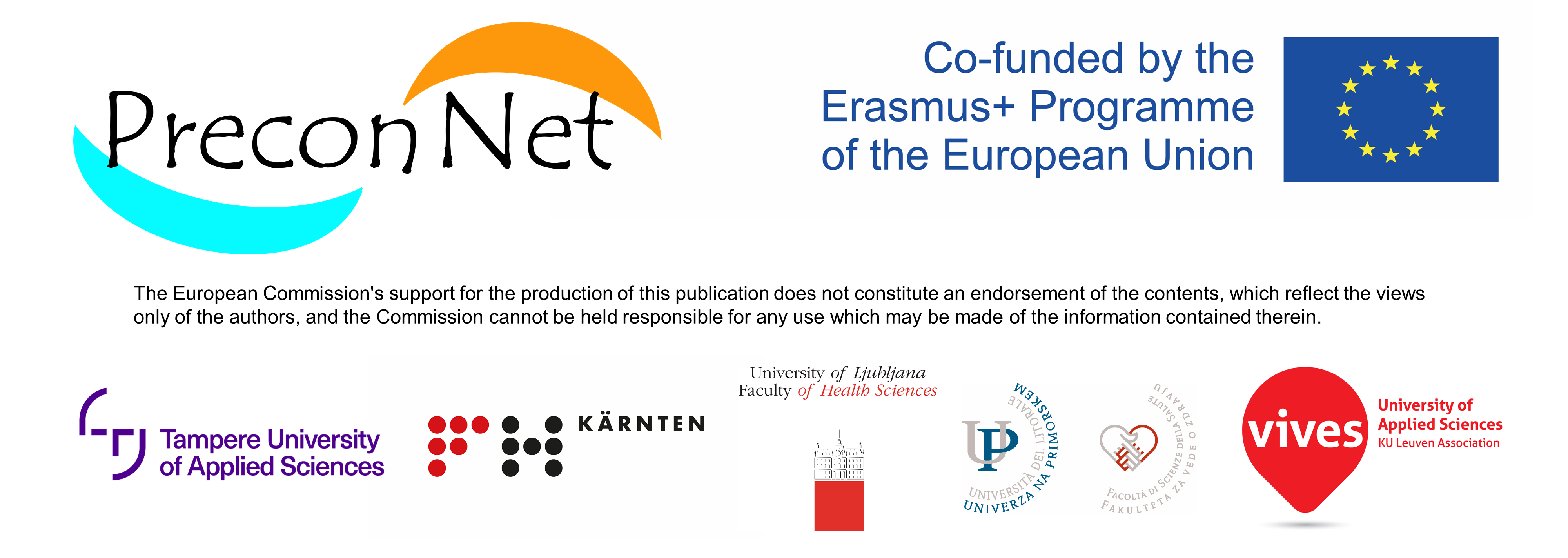DESCRIPTION OF THE PCHC-MODEL FOR EDUCATORS

Age affects the ability to conceive. Maternal/female and paternal/male fertility declines as women and men age. Age is the single biggest factor affecting a woman’s fertility. For men, age-related fertility decline is more subtle but does happen as well. While the effects of female age on fertility have been known for a long time, more recent studies show that the age of the male partner also affects the chance of pregnancy and overall pregnancy health.
Many women and men lack knowledge about fertility, including the anatomy and physiological functioning of their reproductive system. This item teaches you to understand how conception happens.
Lifestyle factors are habits and choices of life that can influence overall health and well-being, including fertility. The influence that lifestyle factors have on fertility deserves our attention. There are lifestyle factors that negatively influence fertility while others are beneficial for fertility of both men and women.
Infections (infectious diseases) can impact the reproductive health of women and men. These infections range from sexually transmitted infections (STIs) to TORCHS infections. Risk assessment, screening, and treatment for specific infections should be a component of preconception care.
Pre-existing medical conditions
Certain (chronic) medical conditions, in both men and women, increase the risk of infertility issues and risk of having an unhealthy child. Because pre-existing medical conditions have been associated with poor pregnancy outcomes, screening by a professional is advised. Following conditions need attention in good time before pregnancy: diabetes, endocrine, neurological, cardiovascular, gastrointestinal, renal, immunological and hematological disorders.
Environmental exposures in critical periods during pregnancy may result in lifelong or intergenerational adverse health effects. Most chemicals in commercial use have not been tested for possible fertility toxicity. Environmental exposure can result in adverse effects of female and male reproduction. Identifying men and women at risk, providing counselling about the impact of chemical toxicants, and empowering men and women to take precautionary action, is stated in guidelines for preconception.
Occupational hazards may have an impact on reproductive health of men and women. Evidence is clear and provides guidance for health care professionals working in preconception health and care. Identifying the most susceptible environmental health hazards to fertility is the key to avoid future problems.
Social environment and its’ determinants can impact reproductive health. During women’s preconceptional and pre-pregnancy consultations, healthcare providers may have difficulties to discuss socially stigmatized health topics, which are important for health of both mother (to be) and child. Social environment variables can be neighborhood (housing, mobility), education, discrimination (inequalities) and social support from friends, relatives, including interpersonal and intimate partner violence.
Strong evidence exists of the afore mentioned themes. The project and the honeycomb-model synthetize the scientific literature and translates the evidence into tools for education.
Our PCHC-model describes the factors without making priority lists. Fertility is a very individual and unique issue for everyone.
Click on the tab of a specific language to read the translation.
BESCHRIJVING VAN HET PCHC-MODEL VOOR DOCENTEN
Het PCHC-model stelt de inhoud voor en definieert de elementen van preconceptionele gezondheid en zorg. De elementen beschrijven de meest up-to-date evidence op het gebied van gezondheid en preconceptie, zoals biologische en gezondheidsbevorderende factoren, maar psychologische, sociale, ethische en culturele thema’s komen aan bod. Het model is makkelijk te vertalen naar de curricula van de opleidingen van de verschillende landen betrokken in het project. Het “PreconNet honeycomb-model” vormt de leidraad voor de uitwerking van de inhoud, didactische aanpak en leerresultaten. Het model en zijn elementen vormen een kader voor de (e-learning) cursussen en het online platform.
De inhoud van het PCHC-model (honeycomb) beschrijft die factoren die van invloed zijn op de vruchtbaarheid. Onderzoek biedt voortdurend nieuwe informatie, die jongeren en volwassenen moet bereiken willen we om ervoor zorgen dat zij weten hoe ze hun vruchtbaarheid kunnen beschermen.
Tijdens het project zal de inhoud van het Honeycomb-model groeien naarmate er nieuwe inzichten komen.
Leeftijd en vruchtbaarheid
Leeftijd beïnvloedt de kans om al dan niet zwanger te kunnen worden. De vruchtbaarheid van een moeder/vrouw en een vader/man neemt af naarmate zij ouder worden. Leeftijd is de belangrijkste factor die de vruchtbaarheid van een vrouw beïnvloedt.
Voor mannen is de leeftijdsgerelateerde daling van de vruchtbaarheid subtieler, maar is er wel.
Hoewel de effecten van de vrouwelijke leeftijd op de vruchtbaarheid al lang bekend zijn, tonen recentere onderzoeken aan dat de leeftijd van de mannelijke partner ook de kans op zwangerschap en een gezonde zwangerschap beïnvloedt.
Voortplanting begrijpen
Veel vrouwen en mannen hebben onvoldoende of geen kennis over vruchtbaarheid, inclusief de anatomie en het fysiologische functioneren van hun voortplantingssysteem. Dit item leert u begrijpen hoe conceptie plaatsvindt.
Leefstijlfactoren
Leefstijlfactoren zijn gewoonten en levenswijzen die gezondheid en welzijn in het algemeen, inclusief vruchtbaarheid, kunnen beïnvloeden. De invloed die deze leefstijlfactoren hebben op de vruchtbaarheid verdient onze bijzondere aandacht.
Er zijn factoren die de vruchtbaarheid negatief beïnvloeden, terwijl andere gunstig zijn voor de vruchtbaarheid van mannen en vrouwen.
Infectierisico’s
Infecties kunnen de reproductieve gezondheid van vrouwen en mannen beïnvloeden. Deze infecties variëren van seksueel overdraagbare aandoeningen (SOA’s) tot de TORCHS-infecties. Risicodetectie, screening en behandeling van specifieke infecties moeten een onderdeel zijn van preconceptiezorg.
Chronische aandoeningen
Bepaalde (chronische) medische aandoeningen, bij mannen en vrouwen, verhogen het risico op vruchtbaarheidsproblemen of op het krijgen van een baby met bepaalde medische aandoeningen. Omdat reeds bestaande medische aandoeningen in verband zijn gebracht met zwangerschapscomplicaties, wordt screening naar deze aandoeningen door de zorgverlener aanbevolen. Dit geldt voor volgende aandoeningen: endocriene aandoeningen, diabetes mellitus, neurologische aandoeningen, cardiovasculaire aandoeningen, gastro-intestinale aandoeningen, nieraandoeningen, immunologische aandoeningen, hematologische aandoeningen
Blootstelling aan het milieu
Blootstelling aan schadelijke milieufactoren tijdens de zwangerschap kan leiden tot nadelige levenslange of intergenerationele gezondheidseffecten. De meeste chemicaliën die commercieel worden gebruikt, zijn niet getest op mogelijke toxiciteit. Blootstelling hieraan kan nadelige effecten hebben op de vrouwelijke en mannelijke reproductie. Het identificeren van mannen en vrouwen die risico lopen, het geven van advies over de impact van chemische toxische stoffen en mannen en vrouwen aanmoedigen om voorzorgsmaatregelen te nemen, staan vermeld in richtlijnen voor preconceptie.
Beroepsrisico’s
Gevolgen gelinkt aan het beroep kunnen van invloed zijn op de reproductieve gezondheid van mannen en vrouwen. Onderzoek is duidelijk en biedt richtlijnen voor zorgverleners. Het identificeren van zij die het meest vatbaar zijn voor de gevolgen, is de sleutel om toekomstige problemen te voorkomen.
Sociale omgeving
De sociale omgeving en de determinanten ervan kunnen de reproductieve gezondheid beïnvloeden. Tijdens preconceptionele consulten is het voor zorgverleners een uitdaging om een beeld te krijgen van de al dan niet sociaal kwetsbare omgeving van de vrouw, het koppel. Echter, een beeld krijgen van de sociale omgeving is van belang om de gezondheid van zowel de toekomstige moeder als de toekomstige baby te bewaken. Wat verdient onze aandacht m.b.t. sociale omgeving: waar woont de vrouw/het koppel (buurt, huisvesting, mobiliteit), onderwijs, sociale steun van vrienden, familieleden, interpersoonlijk en huiselijk geweld.
Onderzoekt onderbouwt bovenstaande thema’s. Het project en het ‘honeycomb-model’ synthetiseren deze wetenschappelijke literatuur en vertalen het in praktische tools.
De thema’s staan niet in volgorde van belangrijkheid. Vruchtbaarheid en mogelijke problemen zijn heel individueel bepaald.
PCHC-MALLI ”HUNAJAKENNO” OPETTAJILLE JA AMMATTILAISILLE
PCHC-mallissa kuvataan tuoreeseen ja ajankohtaiseen tietoon perustuen hedelmällisyyteen ja lisääntymisterveyteen vaikuttavia tekijöitä. Mallin lähtökohta on terveyden edistäminen; biologiset, psykologiset, sosiaaliset, eettiset ja kulttuuriset näkökulmat. Malli on helppo soveltaa eri maiden opetussuunnitelmiin. Malli voi toimia viitekehyksenä lisääntymisterveyttä edistävässä neuvonnassa ja hoidossa. Hunajakennosto ja sen yksittäiset kennot muodostavat puitteet oppimiselle sekä lähiopetuksessa että verkkokursseilla.
On tärkeää, että uusi tutkimustieto saavuttaisi nuoret ja nuoret aikuiset, jotta he osaisivat suojella hedelmällisyyttään. Oikea tieto vahvistaa heidän kykyä tehdä viisaita valintoja, mikäli he päättävät pidentää nuoruuttaan ja viivästyttää vanhemmuuttaan.
Hedelmällisyyden ja lisääntymisterveyden ymmärtäminen
Nuorilla ja nuorilla aikuisilla ei ole riittävästi tietoa hedelmällisyyteen tai lisääntymisterveyteen vaikuttavista tekijöistä. Ymmärrys anatomiasta, fysiologiasta tai hormoneihin vaikuttavista tekijöistä on puutteellista.
Ikä ja hedelmällisyys
Ikä vaikuttaa hedelmällisyyteen. Sekä naisten että miesten hedelmällisyys, kyky hedelmöittyä ja hedelmöittää, heikkenee iän myötä. Ikä on merkittävin yksittäinen tekijä, joka vaikuttaa hedelmällisyyteen.Miesten ikään liittyvä hedelmällisyyden lasku tapahtuu naisen ikään liittyvää hedelmällisyyden laskua myöhemmin. Naisen iän vaikutukset hedelmällisyyteen on tiedetty jo kauan. Uudet tutkimukset osoittavat, että myös miehen ikä vaikuttaa hedelmöittymiseen ja raskauteen.
Valinnat, joita teemme elämässämme, vaikuttavat terveyteen ja hyvinvointiin, mutta myös hedelmällisyyteen. Sekä tytöt ja naiset että pojat ja miehet voivat vaikuttaa elämäntavoillaan joko positiivisesti tai negatiivisesti omaan hedelmällisyyteensä.
Infektiot
Infektiot (tartuntataudit) voivat vaikuttaa naisten ja miesten lisääntymisterveyteen. Infektiolla tarkoitetaan tässä yhteydessä seksitauteja tai TORCH-infektioita (TORCH eli toksoplasmoosi, vihurirokko, sytomegalo-virus, herpes simplex ja lisäksi syfilis, parvovirus ja Varicella zoster. Zika-virus on myös liitetty TORCH-infektioihin.) Infektiot tulee seuloa ja hoitaa hedelmällisyyden suojelemiseksi.
Perussairaudet
Tietyt krooniset sairaudet saattavat heikentää hedelmällisyyttä ja lisäävät riskiä ongelmiin raskaudessa ja synnytyksen aikana. Perussairaudet on hyvä huomioida hyvissä ajoin, jo raskautta suunniteltaessa, ja keskustella niiden lääkityksestä ammattilaisten kanssa. Ainakin seuraavat perussairaudet on huomioitava raskautta suunniteltaessa: diabetes, endokriiniset tai neurologiset sairaudet, sydän- ja verisuonisairaudet, maha-suolikanavan sairaudet, immunologiset tai hematologiset ongelmat ja häiriöt.
Ympäristö
Ympäristössä oleville kemikaaleille altistuminen hedelmöittymisen tai raskauden aikana voi aiheuttaa haitallisia terveysvaikutuksia. Vaikkakin käytössä olevat kemikaalit on testattu terveyshaittojen suhteen, hedelmällisyysterveyden näkökulma on jäänyt vähemmälle huomiolle. Ilmansaasteille, mikromuoville ja muille kemikaaleille altistuminen voi aiheuttaa naisten ja miesten lisääntymisterveydelle haitallisia vaikutuksia.
Työympäristö
Tietyt työympäristöt voivat aiheuttaa haittoja sekä miesten että naisten lisääntymisterveydelle. Työterveyshuollossa tulisi käsitellä terveyttä myös hedelmällisyyden suojelun kannalta.
Sosiaalinen ympäristö
Sosiaalinen ympäristö vaikuttaa lisääntymisterveyteen. Naisten lisääntymisterveyttä edistävässä ohjauksessa ja neuvonnassa tulisi keskustella hankalista ja ns. sosiaalisesti leimaavista aiheista. Keskustelu on tärkeää, sillä näillä tekijöillä on selkeästi osoitettu olevan vaikutusta raskautta suunnittelevan tai raskaana olevan ja hänen tulevan lapsensa terveydelle. Sosiaalisen ympäristön eriarvoisuutta luovia tekijöitä on tunnistettu ja ne ovat mm.: asuinpaikka, koulutus, työllistyminen, ystävien ja sukulaisten muodostama sosiaalinen verkosto, sekä ihmissuhde- ja lähisuhdeväkivalta.
PCHC -mallin aiheista on jo olemassa vahvaa näyttöä. PreconNet-hanke ja sen tuottama hunajakennosto-malli kokoavat tutkittua ajankohtaista tieteellistä tietoa. Hanke muuttaa tiedon pedagogisesti erilaisiksi, houkutteleviksi ja helposti käyttöönotettaviksi opetusvälineiksi.
PCHC-malli kuvaa hedelmällisyyteen vaikuttavia tekijöitä yleisesti. Malli ei aseta yhtä tekijää hedelmällisyydelle vaikuttavammaksi kuin toista. Eri tekijöiden vaikutus yksilön hedelmällisyyteen on erilainen eri ihmisillä ja siksi hedelmällisyyden suojelu on jokaiselle yksilöllinen tekijöiden summa.
DESCRIPTION DU MODELE PCHC POUR LES ENSEIGNANTS
Le modèle PCHC encandre le contenu et définit les éléments de la santé et des soins préconceptionnels. Les éléments décrivent les dernières approches en matière de santé et de soins préconceptionnels, y compris les approches biologiques et de promotion de la santé, ainsi que les thèmes psychologiques, sociaux, éthiques et culturels. Le modèle est facile à traduire dans les programmes des pays particpants. Le « PreconNet Honeycomb model » (modèle en nid d’abeille PreconNet) guide l’élaboration du contenu, l’approche didactique et les résultats d’apprentissage en ce qui concerne la préconception, la santé preconceptionnelle. Le modèle et ses éléments forment un cadre pour les cours (e-learning) et la plateforme en ligne.
Le contenu du modèle PCHC décrit les facteurs qui influencent la fertilité. La recherche révèle constamment de nouvelles informations, qui devraient être transmises aux jeunes et aux adultes afin qu’ils sachent comment protéger leur fertilité.
Le contenu du modèle Honeycomb augmentera au cours du projet, à mesure que de nouvelles perspectives émergeront.
Âge et fertilité
L’âge affecte la capacité de concevoir. La fécondité maternelle/féminine et paternelle/masculine diminue à mesure que les femmes et hommes vieillissent. L’âge est le principal facteur affectant la fertilité d’une femme.
Pour les hommes, la baisse de la fécondité liée à l’âge est plus subtile mais elle existe.
Bien que les effets de l’âge des femmes sur la fertilité soient connus depuis longtemps, des études plus récentes montrent que l’âge du partenaire masculin affecte également les chances de grossesse et une grossesse en bonne santé.
Comprendre la reproduction
De nombreuses femmes et hommes manquent de connaissance sur la fertilité, y compris l’anatomie et le fonctionnement physiologique de leur système reproducteur. Cet article vous apprend à comprendre comment se déroule la conception.
Facteurs de style de vie
Les facteurs liés au mode de vie sont les habitudes et les modes de vie qui peuvent influer sur la santé et le bien-être en général, y compris la fertilité. L’influence de ces facteurs de style au mode de vie sur la fertilité mérite notre attention.
Il existe des facteurs qui affectent négativement la fertilité tandis que d’autres sont bénéfiques pour la fertilité des hommes et des femmes.
Risques d’infection
Les infections peuvent affecter la santé génésique des femmes et des hommes. Ces infections vont des infections sexuellement transmissibles (IST) aux infections TORCHS. L’évaluation des risques, le dépistage et le traitement d’infections spécifiques devraient être une composante des soins préconceptionnels.
Conditions chroniques préexistantes
Certaines conditions médicales (chroniques), chez les hommes et les femmes, augmentent le risque d’avoir des problèmes de fertilité ou d’avoir un bébé qui aura certaines conditions médicales. Étant donné que des conditions médicales préexistantes ont été associées à des complications de la grossesse, le dépistage de ces conditions est recommandé par le professionnel de la santé. Les conditions suivantes nécessitent une attention particulière: les problèmes endocriniens, neurologiques, cardiovasculaires, gastro-intestinaux, rénaux, immunologiques, hématologiques
Facteurs environnementaux
L’exposition à des facteurs environnementaux nocifs pendant les périodes critiques de la grossesse peuvent entraîner des effets néfastes sur la santé à long terme ou intergénérationnels. La plupart des produits chimiques à usage commercial n’ont pas été testés pour leur toxicité potentielle. L’exposition à cela peut avoir des effets néfastes sur la reproduction féminine et masculine. L’identification des hommes et des femmes à risque, la fourniture de conseils sur l’impact des produits chimiques toxiques et l’encouragement des hommes et des femmes à prendre des précautions sont énumérés dans les directives préconceptionnelles.
Environnement professionnel
Les risques professionnels peuvent avoir un impact sur la santé génésique des hommes et des femmes. La récherche scientifique est claire et fournissent des conseils aux professionnels. Identifier les personnes les plus sujettes aux risques est essentiel pour éviter de futurs problèmes.
Environnement social
L’environnement social et ses déterminants peuvent avoir un impact sur la santé génésique. Au cours des consultations préconceptionnelles des femmes, il est difficile pour les soignants de se faire une idée de l’environnement socialement vulnérable de la femme, le couple. Cependant, obtenir une image de l’environnement social est important pour surveiller la santé de la future mère et du futur bébé. Ce qui mérite notre attention en ce qui concerne l’environnement social: où vit la femme / le couple (quartier, logement, mobilité), l’éducation, le soutien social des amis, des membres de la famille, la violence interpersonnelle et domestique.
Pour les thèmes susmentionnés, des preuves solides existent. Le projet et le modèle synthétisent la littérature scientifique et la traduisent dans des outils pratiques.
Notre modèle PCHC décrit les facteurs sans faire de liste de priorités car la fertilité est un problème très individuel.
BESCHREIBUNG DES PCHC – MODELLS (Modell der präkonzeptionellen Gesundheit) FÜR LEHRENDE
Das Modell der präkonzeptionellen Gesundheit (Preconception Healthcare Model) formt den Inhalt und definiert die Elemente von präkonzeptioneller Gesundheit und Betreuung. Die Elemente des Modells beschreiben die neuesten Erkenntnisse in der präkonzeptionellen Gesundheit und Betreuung und beinhalten neben biologischen, auch gesundheitsfördernde, psychologische, soziale, ethische und kulturelle Perspektiven.
Das Honigwaben Modell kann leicht in die Lehrpläne der Gesundheitsstudiengänge in den teilnehmenden Ländern integriert werden und dient dabei als Leitfaden für die konkrete Erarbeitung der Lehrinhalte, des Lehransatzes und der Lernergebnisse zu den Themen Präkonzeption, präkonzeptionelle Gesundheit und Betreuung. Das Modell und seine Elemente bilden dabei einen Rahmen für die (E – learning) Kurse und die Online – Plattform.
Im PCHC Modell (Honigwabe) werden Faktoren beschrieben, die die Fruchtbarkeit beeinflussen. Die Forschung liefert ständig neue Erkenntnisse, welche an Jugendliche und Erwachsenen weitergegeben werden sollten, damit sie wissen wie sie ihre Fruchtbarkeit schützen und gute Entscheidungen treffen können. Der Inhalt des Honigwaben Modells wird im Laufe des Projekts wachsen. Der Ausgangspunkt sind Faktoren mit hoher Beweiskraft für ihre Auswirkungen auf die Fruchtbarkeit.
Alter und Fruchtbarkeit
Das Alter beeinflusst die Fähigkeit schwanger zu werden. Sowohl die Fruchtbarkeit der Frau, als auch die Fruchtbarkeit des Mannes nimmt mit steigendem Alter ab. Das Alter ist der wichtigste Einflussfaktor welcher die weibliche Fruchtbarkeit beeinflusst. Bei Männern ist die altersbedingte Abnahme der Fruchtbarkeit zwar subtiler, aber trotzdem vorhanden. Während die Auswirkungen des Alters auf die Fruchtbarkeit von Frauen schon lange Zeit bekannt sind, zeigen jüngere Studien, dass auch das Alter des männlichen Partners die Chance einer Schwangerschaft und die Gesundheit in der Schwangerschaft beeinflusst.
Fortpflanzung verstehen
Viele Frauen und Männer haben zu wenig Wissen über die Fruchtbarkeit an sich, inklusive über die Anatomie und physiologische Funktionen des Reproduktionssystems. Dieser Teil des Modells zeigt, wie Empfängnis funktioniert.
Lebensstilfaktoren
Lebensstilfaktoren sind Gewohnheiten und Lebensentscheidungen, die die Gesundheit und das Wohlbefinden im Allgemeinen, inklusive der Fruchtbarkeit, beeinflussen können. Die Aufmerksamkeit soll dabei auf jene Lebensstilfaktoren gerichtet werden, die Einfluss auf unsere Fruchtbarkeit haben. Es gibt Lebensstilfaktoren, die unsere Fruchtbarkeit negativ beeinflussen, während andere vorteilhaft für die Fruchtbarkeit bei Männern und Frauen sind.
Infektionsrisiken
Infektionen (Infektionskrankheiten) können die Reproduktionsgesundheit von Frauen und Männern beeinflussen. Diese Infektionen reichen von sexuell übertragbaren Infektionen (sexual transmitted infections – STIs), bis hin zu STORCH Infektionen. Risikobewertung, Screenings und Behandlung für spezifische Infektionen sollten eine Komponente von präkonzeptioneller Betreuung sein.
Vorerkrankungen
Bestimmte (chronische) Krankheiten bei Männern und Frauen erhöhen das Risiko einer Unfruchtbarkeit und das Risiko dafür, ein nicht gesundes Kind auf die Welt zu bringen. Da gewisse Vorerkrankungen mit einem schlechteren Schwangerschaftsoutcome in Verbindung gebracht werden, werden Screenings durch Gesundheitsexpert*innen empfohlen. Vor allem folgende Erkrankungen sollte frühzeitig (bereits vor der Planung der Schwangerschaft) Beachtung geschenkt werden: Diabetes, Stoffwechselstörungen, neurologische Störungen, kardiovaskuläre Störungen, Nierenerkrankungen, Immunkrankheiten und Blutkrankheiten.
Umwelteinflüsse
In sensiblen Phasen der Schwangerschaft können Umwelteinflüsse lebenslange, ja sogar generationsübergreifende gesundheitsschädliche Auswirkungen nach sich ziehen. Die meisten Chemikalien, welche gewerblich genutzt werden, wurden nicht auf mögliche toxische Auswirkungen auf die Fruchtbarkeit getestet. Schädliche Auswirkungen auf die weibliche und männliche Reproduktivität können die Folge von Umwelteinflüssen sein. Leitlinien für präkonzeptionelle Gesundheit und Betreuung empfehlen daher die Identifikation von Männern und Frauen mit einem Risiko, das Angebot von Beratungen über den Einfluss von chemischen Stoffen und die Befähigung von Männern und Frauen vorbeugende Maßnahmen in Anspruch zu nehmen.
Arbeitswelt/Arbeitsumwelt
Unterschiedliche Berufsrisiken können Einfluss auf die Reproduktionsgesundheit von Männern und Frauen haben. Hier ist die Evidenz klar und bietet Richtlinien für Expert*innen im Gesundheitswesen, die im Feld präkonzeptionelle Gesundheit und Betreuung arbeiten. Um zukünftige Probleme zu vermeiden, ist es wichtig. die für die Fruchtbarkeit gesundheitsgefährdendsten Umgebungseinflüsse zu identifizieren.
Soziales Umfeld
Das soziale Umfeld und seine Einflussfaktoren können die Reproduktionsgesundheit ebenfalls beeinflussen. Für Gesundheitsdienstleister*innen ist es oftmals schwierig sozial stigmatisierende Gesundheitsthemen in den präkonzeptionellen Beratungen mit den Frauen anzusprechen, obwohl diese wichtig für die Gesundheit der zukünftigen Mutter und deren Kind sind. Variablen des sozialen Umfelds können die Nachbarschaft (Wohnung, Mobilität), Bildung, Diskriminierung (Ungleichheit) und soziale Unterstützung von Freunden, Verwandten, sowie häusliche Gewalt sein.
Für alle oben genannten Themen gibt es eine hohe Beweiskraft. Im Projekt und dem Honigwaben Modell wird die wissenschaftliche Literatur synthetisiert und die Evidenz in Werkzeuge für den Unterricht übersetzt.
Unser Modell der präkonzeptionellen Gesundheit beschreibt die einflussnehmenden Faktoren, ohne eine Reihung derselben durchzuführen. Fruchtbarkeit ist ein sehr individuelles und spezifisches Thema für das Individuum.
OPIS PCHC-MODELA ZA EDUKATORE
PCHC model uokviruje sadržaj i definira elemente reproduktivnog zdravlja i njege. Elementi opisuju najnovije pristupe u reproduktivnom zdravlju i njezi, uključujući biološki pristup i pristup promocije zdravlja, kao i psihološke, socijalne, etičke i kulturalne perspektive. Sudjelujuće države mogu model lako prevesti u kurikulume studijskih programa u području zdravstva. Model saća služi kao vodič za konkretnu razradu sadržaja, didaktički pristup i ishode učenja povezanih s reproduktivnim zdravljem i njegom. Model i njegovi elementi čine okvir za (e-learning) predavanja i online platformu.
Sadržaj PCHC modela (saća) opisuje čimbenike koji utječu na plodnost. Istraživanja neprestano otkrivaju nove informacije koje bi trebalo prenijeti na mlade i druge odrasle kako bi osigurali da znaju zaštititi svoju plodnost te im pomoći da donose mudre odluke. Sadržaj Modela saća će rasti tijekom projekta. Polazimo od čimbenika koji snažno temelje na dokazima o učincima na plodnost.
Starost i plodnost
Dob utječe na sposobnost začeća. Plodnost majki / žena i očeva / muškaraca opada kako stare žene i muškarci. Starost je najveći faktor koji utječe na plodnost žene. Za muškarce je opadanje plodnosti povezano s godinama suptilnije, ali se isto tako događa. Iako su učinci ženske dobi na plodnost poznati već duže vrijeme, novija istraživanja pokazuju da dob muškog partnera također utječe na vjerojatnost za trudnoću i cjelokupno zdravlje trudnoće.
Razumijevanje reprodukcije
Mnogim ženama i muškarcima nedostaje znanja o plodnosti, uključujući anatomiju i fiziološko funkcioniranje njihovog reproduktivnog sustava. Ova čestica vas uči da razumijete kako se događa začeće.
Čimbenici životnog stila
Čimbenici životnog stila su navike i životni izbori koji mogu utjecati na opće zdravlje i životnu dobrobit, uključujući plodnost. Utjecaj koji čimbenici načina života imaju na plodnost zaslužuje našu pažnju. Postoje životni čimbenici koji negativno utječu na plodnost, dok su drugi korisni za plodnost i muškaraca i žena.
Rizici od infekcije
Infekcije (zarazne bolesti) mogu utjecati na reproduktivno zdravlje žena i muškaraca. Te infekcije kreću se od seksualno prenosivih infekcija (STI) do TORCH infekcija. Procjena rizika, nadzor i liječenje specifičnih infekcija trebaju biti sastavni dio skrbi za reproduktivno zdravlje.
Postojeća medicinska stanja
Određena (kronična) zdravstvena stanja, i kod muškaraca i kod žena, povećavaju rizik za probleme s neplodnošću i rizik za rođenje nezdravog djeteta. Budući da su postojeća medicinska stanja povezana s slabijim ishodima trudnoće, savjetuje se nadzor stručnjaka. Sljedeća stanja potrebna su pažnje u vremenu prije trudnoće: dijabetes, endokrini, neurološki, kardiovaskularni, gastrointestinalni, bubrežni, imunološki i hematološki poremećaji.
Izloženost u okolišu
Izloženost u okolišu u kritičnim razdobljima tijekom trudnoće može rezultirati cjeloživotnim ili međugeneracijskim štetnim učincima. Većina kemikalija u komercijalnoj upotrebi nije ispitana na moguću toksičnost plodnosti. Izloženost u okolišu može rezultirati štetnim učincima na žensku i mušku reprodukciju. Utvrđivanje muškaraca i žena u riziku, pružanje savjeta o utjecaju kemijskih toksičnih tvari i osnaživanje muškaraca i žena na mjere predostrožnosti navedeni su u smjernicama za skrb za reproduktivno zdravlje.
Profesionalno okruženje
Profesionalne opasnosti mogu imati utjecaj na reproduktivno zdravlje muškaraca i žena. Dokazi su jasni i pružaju smjernice za zdravstvene radnike koji rade u području reproduktivnog zdravlja i njege. Identifikacija najsuptilnijih zdravstvenih prijetnji za plodnost je ključ da se izbjegnu problemi u budućnosti.
Društveno okruženje
Društveno okruženje i njegove odrednice mogu utjecati na reproduktivno zdravlje. Tijekom savjetovanja za žene, koje se provodi prije začeća i trudnoće, pružatelji zdravstvenih usluga mogu imati poteškoća u raspravi o socijalno stigmatiziranim zdravstvenim temama koje su važne za zdravlje majke (ili buduće majke) i djeteta. Varijable u društvenom okruženju mogu biti susjedstvo (smještaj, mobilnost), obrazovanje, diskriminacija (nejednakosti) i socijalna podrška prijatelja, rođaka, uključujući nasilje nad čovjekom ili nasilje od strane intimnog partnera.
Postoje snažni dokazi o gore spomenutim temama. Projekt i model saća sintetiziraju znanstvenu literaturu i prevode dokaze u alate za obrazovanje.
Naš PCHC model opisuje čimbenike bez prioritetiziranja. Plodnost je vrlo individualan i jedinstven problem za svakog pojedinca.
DESCRIZIONE DEL MODELLO PCHC PER GLI EDUCATORI
Il modello PCHC inquadra il contenuto e definisce gli elementi della salute e dell’assistenza preconcezionale. Gli elementi descrivono le misure riguardanti la salute e l’assistenza preconcezionale che comprendono così approcci biologici e della promozione della salute che prospettive psicologiche, sociali, etiche e culturali. Il modello è facile da introdurre nei curricula dei corsi sanitari dei paesi partecipanti. Il modello a nido d’ape funge da guida per l’elaborazione concreta del contenuto, dell’approccio didattico e dei risultati di apprendimento in materia della salute preconcezionale. Il modello e i suoi elementi formano un framework per i corsi (e-learning) e la piattaforma web.
Il contenuto del modello PCHC (nido d’ape) descrive i fattori che influenzano la fertilità. La ricerca riporta costantemente nuove informazioni che dovrebbero essere passate a giovani e adulti per aiutarli a proteggere la loro fertilità e a fare scelte sagge. Il contenuto del modello a nido d’ape si evolverà e amplierà durante il progetto. Partiamo da fattori con una forte evidenza di effetti sulla fertilità.
Età e fertilità
L’età influisce sulla capacità di concepire. La fertilità materna / femminile e paterna / maschile diminuisce con l’età delle donne e degli uomini. L’età è il fattore più importante che influenza la fertilità di una donna. Per gli uomini, il declino della fertilità legato all’età è più sottile, ma si verifica anche in questo caso. Mentre gli effetti dell’età femminile sulla fertilità sono noti da molto tempo, studi più recenti dimostrano che anche l’età del partner maschile influisce sulla possibilità di gravidanza e sulla salute generale della gravidanza.
Capire la riproduzione
Molte donne e molti uomini sono ignoranti quando si parla di fertilità, non conosco l’anatomia e il funzionamento fisiologico del loro sistema riproduttivo. Questa parte del modello insegnerà a capire come avviene il concepimento.
Fattori dello stile di vita
I fattori dello stile di vita sono abitudini e scelte di vita che possono influenzare la salute e il benessere generale, compresa la fertilità. L’influenza che i fattori dello stile di vita hanno sulla fertilità meritano la nostra attenzione. Ci sono fattori dello stile di vita che influenzano negativamente la fertilità, mentre altri sono benefici per la fertilità sia degli uomini che delle donne.
Rischi di infezione
Le infezioni (malattie infettive) possono influire sulla salute riproduttiva di donne e uomini. Queste infezioni vanno dalle infezioni sessualmente trasmissibili (IST) alle infezioni TORCH. La valutazione del rischio, lo screening e il trattamento di infezioni specifiche dovrebbero essere una componente dell’assistenza preconcezionale.
Condizioni mediche preesistenti
Alcune condizioni mediche (croniche), sia negli uomini che nelle donne, aumentano il rischio di problemi d’infertilità e di avere un bambino non sano. Poiché condizioni mediche preesistenti vengono associate a scarsi esiti della gravidanza, si consiglia un controllo effettuato da parte di un professionista sanitario. Le seguenti condizioni richiedono attenzione in tempo utile prima della gravidanza: diabete, disturbi endocrini, neurologici, cardiovascolari, gastrointestinali, renali, immunologici ed ematologici.
Esposizioni ambientali
Le esposizioni ambientali in periodi critici durante la gravidanza possono provocare effetti negativi sulla salute dell’individuo per tutta la vita o addirittura intergenerazionali. La maggior parte delle sostanze chimiche in uso commerciale non è stata testata per una possibile tossicità per la fertilità. L’esposizione ambientale può provocare effetti negativi sulla riproduzione femminile e maschile. L’identificazione di uomini e donne a rischio, la consulenza sull’impatto di sostanze chimiche tossiche e la responsabilizzazione di uomini e donne ad adottare misure precauzionali, è indicata nelle linee guida per la preconcezione.
Ambiente professionale
I rischi professionali possono avere un impatto sulla salute riproduttiva di uomini e donne. Le prove sono chiare e forniscono una guida per i professionisti sanitari che lavorano nel settore della salute e dell’assistenza preconcezionale. Identificare i pericoli dell’ambiente professionale più suscettibili alla fertilità è la chiave per evitare problemi futuri.
Ambiente/contesto sociale
L’ambiente/contesto sociale e i suoi determinanti possono avere un impatto sulla salute riproduttiva. Durante le consultazioni preconcezionali e pre-gravidanza delle donne, i professionisti sanitari possono avere difficoltà a discutere argomenti di salute socialmente stigmatizzati, che sono importanti per la salute sia della (futura) madre che del bambino. Le variabili dell’ambiente sociale possono essere il vicinato (alloggio, mobilità), l’istruzione, la discriminazione (disuguaglianze) e il sostegno sociale da parte di amici, parenti, compresa la violenza interpersonale e intima dei partner.
Esistono prove concrete dei suddetti temi. Il progetto e il modello a nido d’ape sintetizzano la letteratura scientifica e traducono le prove in strumenti per l’educazione.
Il nostro modello PCHC descrive i fattori senza fare liste di priorità. La fertilità è una questione molto individuale e unica per tutti.
OPIS MODELA PREDKONCEPCIJSKE ZDRAVSTVENE OBRAVNAVE (PKZO) ZA IZOBRAŽEVALCE
Starost in plodnost
Starost vpliva na zmožnost spočetja. Sposobnost oploditve ženske in moškega z višanjem starosti upada. Starost je najmočnejši individualni dejavnik, ki vpliva na rodnost žensk. Pri moških je povezava med starostjo in plodnostjo bolj subtilna, a vseeno dokazana. Medtem, ko je vpliv višje starosti ženske na njeno plodnost že dolgo prepoznan, novejše študije sedaj jasno potrjujejo tudi povezavo med višjo starostjo moškega in njegovo zmožnostjo za spočetje otroka ter zdravstvenimi komplikacijami v nosečnosti.
Veliko moških in žensk nima dovolj znanja o plodnosti, vključno z dejstvi o anatomiji in fiziologiji reproduktivnega sistema. Zato smo v tem sklopu modela zbrali informacije za boljše razumevanje kako do spočetja pride.
Odločitve za zdrav življenjski stil
Življenjski stil oblikujejo osebne odločitve. Življenjske navade posameznika torej vplivajo na njegovo zdravje in dobrobit, torej tudi na plodnost. Dejavniki, ki so plod osebnih odločitev in pozitivno ali negativno delujejo na moško in žensko plodnost zahtevajo posebno pozornost, saj jih je s spremembo življenjskega sloga možno spreminjati ter tako krepiti ali omiliti njihov vpliv.
Tveganje za infekcije
Infekcije (oz. infekcijske bolezni) lahko delujejo na reproduktivne sposobnosti moškega in/ali ženske. To so okužbe kot na primer spolno prenosljive infekcije (Sexually Transmitted Infections – STIs) ali TORCH infekcije (Toxoplasmosis; Other – syphilis, varicella-zoster, parvovirus B19; Rubella; Cytomegalovirus; Herpes – TORCHs). Ocena tveganja, presejanje in diagnostika ter zdravljenje teh infekcij bi moral biti integralni del predkoncepcijske zdravstvene obravnave para.
Predhodna obolenja
Določena (kronična) obolenja lahko tako pri moških kot pri ženskah višajo tveganje za neplodnost oz. vplivajo na poznejše zdravje otroka. Predhodna obolenja so povezana tudi s slabimi izidi nosečnosti, zato se svetuje predhodno presejanje. Stanja, ki zahtevajo pozorno spremljanje s strani zdravstvenih strokovnjakov še pred zanositvijo so: presnovna, endokrina, nevrološka, kardiovaskularna, gastrointestinalna, ledvična, imunološka in hematološka obolenja.
Izpostavljenost okoljskim vplivom
Izpostavljenost negativnim okoljskim vplivom v kritičnih trenutkih med nosečnostjo, lahko prinaša dolgoročne in medgeneracijske škodljive posledice za zdravje. Vpliv velike večine kemikalij v vsakodnevni rabi na plodnost ni bil nikoli ocenjen. Dolgotrajna izpostavljenost lahko škodljivo vpliva na reproduktivno sposobnost moških in žensk. Opredelitev posameznikov in posameznic z večjim tveganjem je nujno, da se jim lahko ponudi svetovanje o vplivu kemičnih toksinov na njihovo plodnost ter se jih opolnomoči in podpre v ukrepih za aktivno preprečevanje izpostavljenosti škodljivim dejavnikom.
Delavno okolje
Nekatera tveganja za reproduktivno sposobnost moških in žensk predstavlja tudi delovno okolje. Jasni dokazi omogočajo zdravstvenim strokovnjakom usmeritve za učinkovito predkoncepcijsko obravnavo. Opredelitev najpogostejših in za prevencijo dovzetnih dejavnikov tveganja, ki lahko ogrozijo plodnost posameznikov na delovnem mestu, mora biti osnova zdravstveno vzgojnega dela zdravstvenih strokovnjakov, da lahko preprečijo probleme v prihodnosti.
Družbeno okolje
Družbeno okolje in njegove determinante lahko vplivajo na reproduktivno zdravje. Zdravstveni strokovnjaki imajo včasih zadržke v času svetovanj pred zanositvijo oz. nosečnostjo razpravljati o zdravstvenih temah, povezanih s stigmo, vendar pa so le-te pomembno povezane z zdravjem bodoče mame in otroka. Spremenljivke socialnega okolja so lahko soseska (mobilnost), izobrazba, (ne-)enakost (diskriminacija) in socialna opora s strani prijateljev, sorodnikov. Nasloviti je potrebno tudi morebitno nasilje v partnerski zvezi.
Model PKZO navaja dejavnike, ki vplivajo na plodnost, vendar jih ne razvršča po pomembnosti. Plodnost je izjemno individualna in edinstvena značilnost vsakega posameznika oz. posameznice.
BESKRIVNING AV PCHC-MODELLEN FÖR UTBILDARE
PCHC-modellen ramar in innehållet och definierar elementen i Preconception Health and Care (Hälsa ovh vård före befruktning). PCHC-modellen är baserat på färska och uppdaterade data. Utgångspunkten för modellen är hälsofrämjande och innehåller biologiska, psykologiska, sociala, etiska och kulturella aspekter. Modellen är lätt att tillämpa på läroplanerna i olika länder. Modellen kan fungera som referensram för rådgivning och behandling av reproduktiv hälsa. Honeycomb-modellen (honungskakan) och dess enskilda celler ger en ram för (e-learning) kurserna och vår PreconNet online-plattformen.
Innehållet i PCHC-modellen (Honeycomb) beskriver faktorer som påverkar fertiliteten. Forskning avslöjar ständigt ny information som bör överföras till ungdomar och vuxna för att se till att de vet hur man skyddar deras fertilitet och hjälper dem att göra kloka val. Innehållet i Honeycomb-modellen kommer att växa under projektet. Vi utgår från faktorer med starka bevis på fertilitetseffekter.
Ålder och fertilitet
Ålder påverkar fertiliteten. Både kvinnlig och manlig fertilitet, förmågan att bli gravid och befrukta, försämras med åldern. Ålder är den mest betydelsefulla faktorn som påverkar fertiliteten. Åldersrelaterad nedgång i manlig fertilitet inträffar senare än åldersrelaterad nedgång i kvinnlig fertilitet. Effekterna av kvinnans ålder på fertiliteten har varit kända under lång tid. Nya studier visar att mansålder också påverkar fertilitet och graviditet.
Förstå reproduktion
Många kvinnor och män saknar kunskap om fertilitet, inklusive anatomi och fysiologisk funktion i deras reproduktionssystem. Den här delen lär oss att förstå hur befruktningen händer.
Livsstilsfaktorer
Livsstilsfaktorer är vanor och livsval, som kan påverka den allmänna hälsan och välbefinnandet, inklusive fertilitet. Det inflytande som livsstilsfaktorer har på fertilitet förtjänar vår uppmärksamhet. Det finns livsstilsfaktorer som påverkar fertiliteten negativt medan andra är fördelaktiga för fertilitet hos både män och kvinnor.
Infektionsrisk
Infektioner (infektionssjukdomar) kan påverka kvinnors och mäns reproduktiva hälsa. Dessa infektioner sträcker sig från sexuellt överförbara infektioner (STI) till TORCHS-infektioner. Riskbedömning, screening och behandling av specifika infektioner bör vara en del av preconception-vård.
Befintliga medicinska tillstånd
Vissa (kroniska) medicinska tillstånd hos både män och kvinnor, ökar risken för infertilitetsproblem och risken för att få ett ohälsosamt barn. Eftersom redan existerande medicinska tillstånd har associerats med dåliga graviditetsresultat rekommenderas screening av en professionell. Följande tillstånd behöver uppmärksammas i god tid före graviditet: diabetes och andra endokrina, neurologiska, kardiovaskulära, gastrointestinala, njur, immunologiska och hematologiska störningar.
Miljöfaktorer
Miljöexponering under kritiska perioder under graviditeten kan leda till livslånga eller negativa hälsoeffekter mellan generationerna. De flesta kemikalier i kommersiellt bruk har inte testats med avseende på fertilitetstoxicitet. Miljöexponering kan leda till negativa effekter av reproduktion av kvinnor och män. Att identifiera män och kvinnor i riskzonen, ge rådgivning om effekterna av kemiska toxiska ämnen och ge män och kvinnor möjlighet att vidta försiktighetsåtgärder, anges i riktlinjer för preconception.
Yrkesmiljö
Yrkesrisker kan påverka mäns och kvinnors reproduktiva hälsa. Beviset är tydligt och ger vägledning för vårdpersonal som arbetar inom preconception hälsa och vård. Att identifiera de mest mottagliga hälsoriskerna för fertilitet är nyckeln för att undvika framtida problem.
Social miljö
Social miljö och dess avgörande faktorer kan påverka reproduktiv hälsa. Under kvinnors rådgivning före och efter graviditet kan vårdgivare ha svårt att diskutera socialt stigmatiserade hälsoämnen, som är viktiga för hälsan hos både mor och barn. Variabler i den sociala miljön kan vara grannskap (bostäder, rörlighet), utbildning, diskriminering (ojämlikhet) och socialt stöd från vänner, släktingar, inklusive våld mellan mänskliga relationer och intim partner.
Det finns starka bevis för de ovan nämnda teman. Projektet och Honeycomb-modellen syntetiserar den vetenskapliga litteraturen och översätter bevisen till verktyg för utbildning.
Vår PCHC-modell beskriver faktorerna utan att göra prioritetslistor. Fertilitet är en mycket individuell och unik fråga för alla.
PCHC-competences in midwife and nurse education
The midwife and nurse student
– knows the factors affecting fertility and PCH
– advises clients and promotes their fertility awareness
– is competent to counsel and support in family planning issues
PreconNet presentation by Magali De Pauw
PreconNet project and PCHC-model leaflet
Click on the image above to download the English version of the leaflet.







